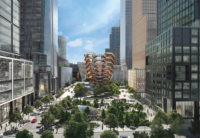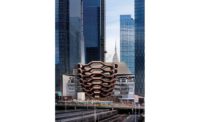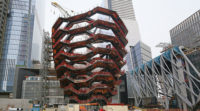“I get to be one of the first art and architecture critics here, and I really like what I see,” said New York City mayor Bill de Blasio at the September 14 unveiling of Thomas Heatherwick’s design for a monumental landmark at Hudson Yards—a $20 billion development along the Manhattan’s west side, spearheaded by Related Companies and Oxford Properties. But his praise came with a word of caution to the London-based designer: “If you meet 100 New Yorkers, you will find 100 different opinions,” he said. “Do not be dismayed—this is just the way we are.”
Drawing comparisons to an M.C. Escher composition, a pinecone, or even an insect’s exoskeleton, Heatherwick’s “Vessel” is a 16-story steel pavilion with 80 viewing platforms, 154 flights of stairs, and almost 2,500 steps. “Our project is about seeing if we could get a mile of public space and stitch it all together,” the designer explains. The project will be the centerpiece of a new public plaza designed by Nelson Byrd Woltz Landscape Architects (NBW) in collaboration with Heatherwick Studio. Related Companies chairman and founder Stephen M. Ross—who has long touted the structure as New York’s “Eiffel Tower”—said at the unveiling, “I wanted to create a 365-day Christmas tree.”
Heatherwick says he and his firm felt “enormous pressure” to create a landmark worthy of its context: Hudson Yards, the largest private real estate development in the United States, will become home to half a dozen residential and commercial skyscrapers by 2025. “We knew we needed to engage with the space and somehow do justice to all these new places and special buildings around,” he says, “But height couldn’t be the primary thing.”
The site’s history didn’t provide design cues either: “Other public spaces commemorate something,” says Heatherwick, pointing to Trafalgar Square, which memorialized a British naval victory. (“Sorry to use a British analogy,” he adds). “But this is all new, with a rail line underneath.”
“We were asked to make a landmark within this mature city, but we didn’t want to make a sculpture for people to just look and clap at,” says Heatherwick. The team pulled inspiration from stepwells—inverted pyramid-shaped water wells with step-lined walls, common in western India. “The act of rhythmically moving up and down multiple flights of stairs seemed to have the potential to become an extraordinary human experience,” says Heatherwick. Vessel’s interconnected passages create a multipurpose space for exercise, meditation, sightseeing, and more, while providing shelter on covered landings and pathways.
The structure will be just one of the many areas of respite at Hudson Yards; almost six acres of plaza and gardens will contain tables, benches, and close to a mile of low walls for sitting. Landscape architect Thomas Woltz, principal and owner of Charlottesville- and New York-based NBW, led the design, working around the many structural constraints that come with a site built seven feet above a working rail yard. “I will never again in my life take for granted being on real earth,” he says. Heat generated by the commuter trains below can reach temperatures of 165 degrees Farenheit—too hot for tree roots to survive—so NBW worked with engineers to embed a glycol tube chilling system in the concrete slab at the base of the landscaping platform. The soil bed, ranging in depth from 19 inches to 4 feet, will support a 225 trees in addition to tens of thousands of shrubs and groundcover plants, which Woltz and his team selected with multi-seasonality in mind: “You'll find red twig dogwood that’s a beautiful flowering shrub in the spring, has nice dark green foliage in the summer, and then in the winter, the stems all turn an incredible glossy red.”
Heatherwick sees the purpose of his Vessel and the Hudson Yards park and plaza as similar to that of the nearby High Line—which, he says, has “revolutionized” how people think of public space. “What’s it for? It isn’t for anything. It just gives you a different perspective and experience.” The public space is slated to open in 2018.
















Post a comment to this article
Report Abusive Comment